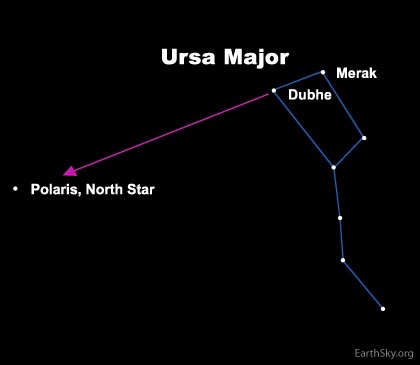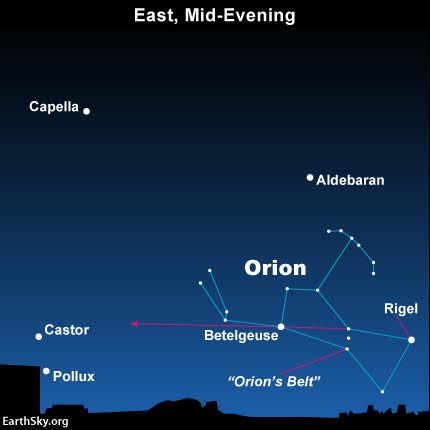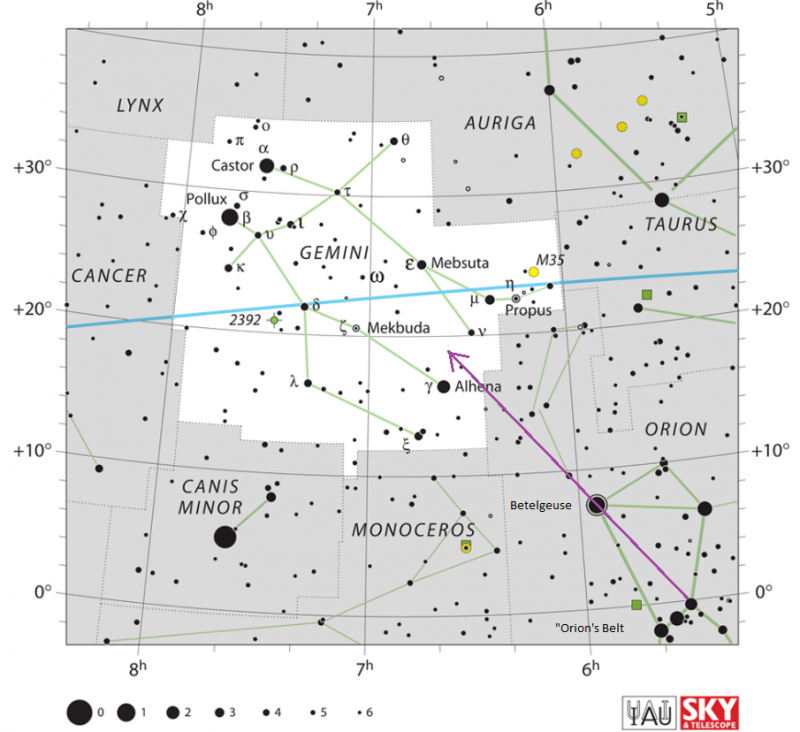
On January 19, 2019, the moon might look full to you, but it’s not yet. Full moon comes when the moon is most opposite the sun. That’ll be January 20 for us in North America, at which time the full supermoon will be totally eclipsed by the Earth’s dark shadow for 62 minutes, starting at 11:41 p.m. EST, 10:41 p.m. CST, 9:41 p.m. MST, 8:41 p.m. PST, 7:41 p.m. Alaskan Time and 6:41 p.m. Hawaiian Time.
Read more: Total lunar eclipse on night of January 20-21
Meanwhile, the January 19 moon is a waxing gibbous moon. It’s near the bright stars Castor and Pollux in the constellation Gemini the Twins.
Although we’ve drawn in the stick figure of the Gemini Twins on the chart at the top of this post, you might not see much of Gemini in the moonlight glare except for Castor and Pollux. These two stars are bright and noticeable for being near one another. They form the northeastern part of the Winter Circle.

You can also use the Big Dipper to locate Castor and Pollux. Draw an imaginary line diagonally through the bowl of the Big Dipper, as shown on the sky chart above.
That brilliant star on the other side of the January 19 moon is Procyon, sometimes called the Little Dog Star.
You might not know that Procyon – and Castor and Pollux – offer an alternate way of finding Polaris, the North Star. You can draw an imaginary line from Procyon and then in between the two Gemini stars, and then take a long jump northward to locate Polaris, the North Star.
Donate: Your support means the world to us

Most people use the two outer stars in the bowl of the Dipper – Dubhe and Merak – to find Polaris, the North Star. A line between these two stars always points to the North Star.
And speaking of star-hopping … Are you familiar with the constellation Orion and the line of three stars known as Orion’s Belt? If, so you can star-hop to the Gemini stars Castor and Pollux, as shown on the sky chart below.

Are you familiar with the constellation Orion and the line of three stars known as Orion’s Belt? If, so you can star-hop to the Gemini stars Castor and Pollux.

Sky chart of the constellation Gemini via IAU. When the moon is no longer in front of Gemini, draw an imaginary line from the westernmost star of Orion’s Belt and through the bright ruddy star Betelgeuse to locate the Gemini stars, Castor and Pollux.
Bottom line: On the night of January 19, 2019, let the full-looking waxing gibbous moon guide your eye to the bright Gemini stars, Castor and Pollux!
Gemini? Here’s your constellation
EarthSky astronomy kits are perfect for beginners. Order today from the EarthSky store
from EarthSky http://bit.ly/2R2zIff

On January 19, 2019, the moon might look full to you, but it’s not yet. Full moon comes when the moon is most opposite the sun. That’ll be January 20 for us in North America, at which time the full supermoon will be totally eclipsed by the Earth’s dark shadow for 62 minutes, starting at 11:41 p.m. EST, 10:41 p.m. CST, 9:41 p.m. MST, 8:41 p.m. PST, 7:41 p.m. Alaskan Time and 6:41 p.m. Hawaiian Time.
Read more: Total lunar eclipse on night of January 20-21
Meanwhile, the January 19 moon is a waxing gibbous moon. It’s near the bright stars Castor and Pollux in the constellation Gemini the Twins.
Although we’ve drawn in the stick figure of the Gemini Twins on the chart at the top of this post, you might not see much of Gemini in the moonlight glare except for Castor and Pollux. These two stars are bright and noticeable for being near one another. They form the northeastern part of the Winter Circle.

You can also use the Big Dipper to locate Castor and Pollux. Draw an imaginary line diagonally through the bowl of the Big Dipper, as shown on the sky chart above.
That brilliant star on the other side of the January 19 moon is Procyon, sometimes called the Little Dog Star.
You might not know that Procyon – and Castor and Pollux – offer an alternate way of finding Polaris, the North Star. You can draw an imaginary line from Procyon and then in between the two Gemini stars, and then take a long jump northward to locate Polaris, the North Star.
Donate: Your support means the world to us

Most people use the two outer stars in the bowl of the Dipper – Dubhe and Merak – to find Polaris, the North Star. A line between these two stars always points to the North Star.
And speaking of star-hopping … Are you familiar with the constellation Orion and the line of three stars known as Orion’s Belt? If, so you can star-hop to the Gemini stars Castor and Pollux, as shown on the sky chart below.

Are you familiar with the constellation Orion and the line of three stars known as Orion’s Belt? If, so you can star-hop to the Gemini stars Castor and Pollux.

Sky chart of the constellation Gemini via IAU. When the moon is no longer in front of Gemini, draw an imaginary line from the westernmost star of Orion’s Belt and through the bright ruddy star Betelgeuse to locate the Gemini stars, Castor and Pollux.
Bottom line: On the night of January 19, 2019, let the full-looking waxing gibbous moon guide your eye to the bright Gemini stars, Castor and Pollux!
Gemini? Here’s your constellation
EarthSky astronomy kits are perfect for beginners. Order today from the EarthSky store
from EarthSky http://bit.ly/2R2zIff

Aucun commentaire:
Enregistrer un commentaire